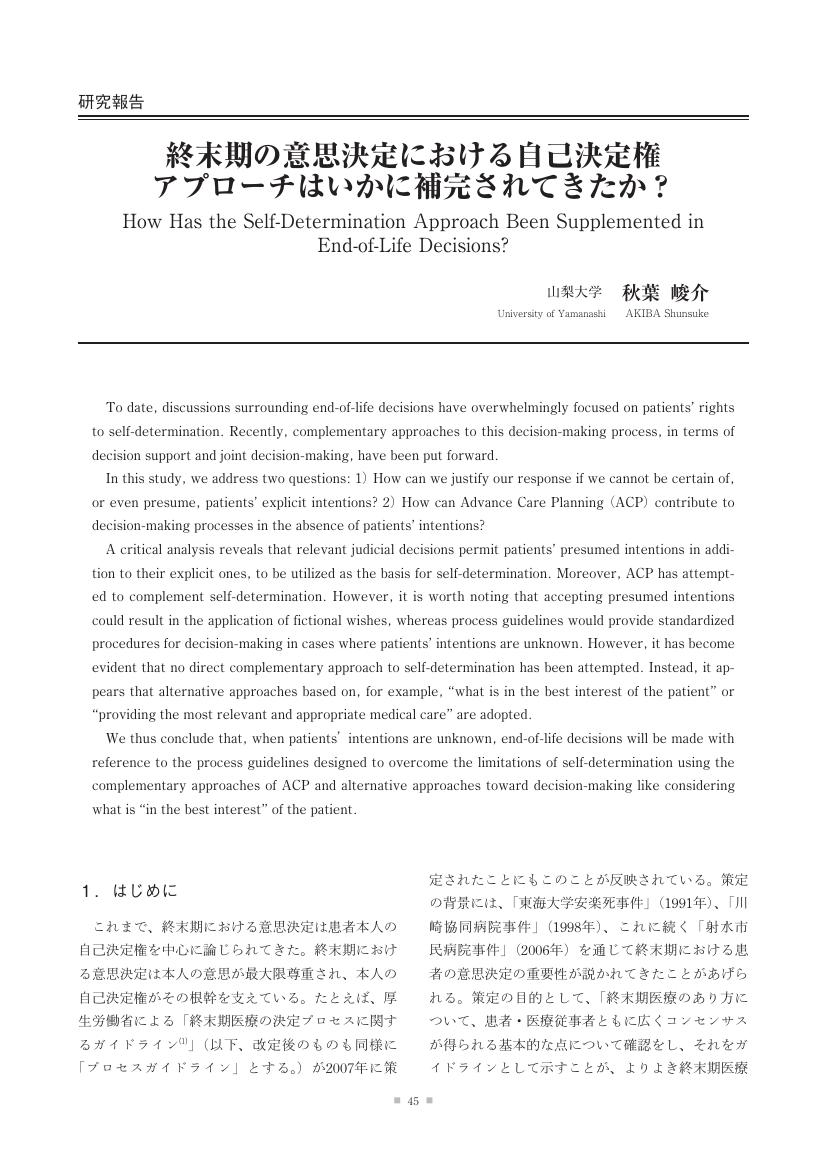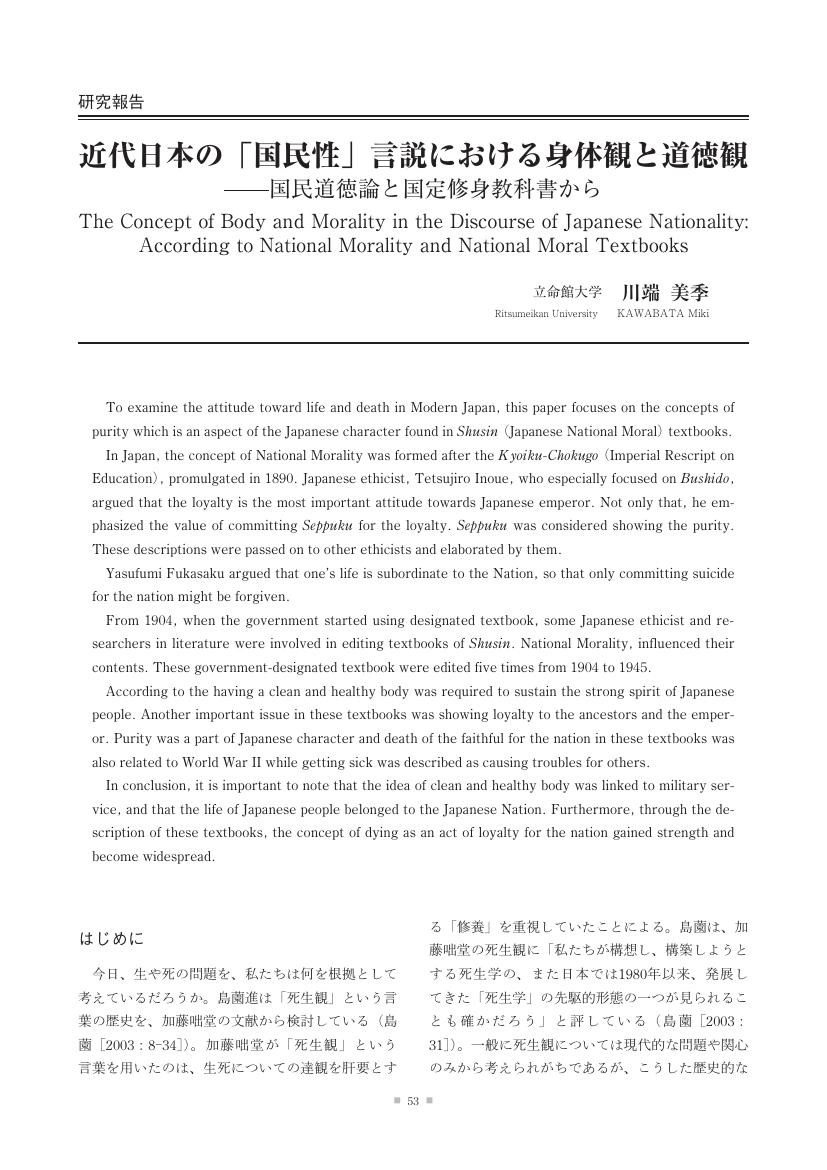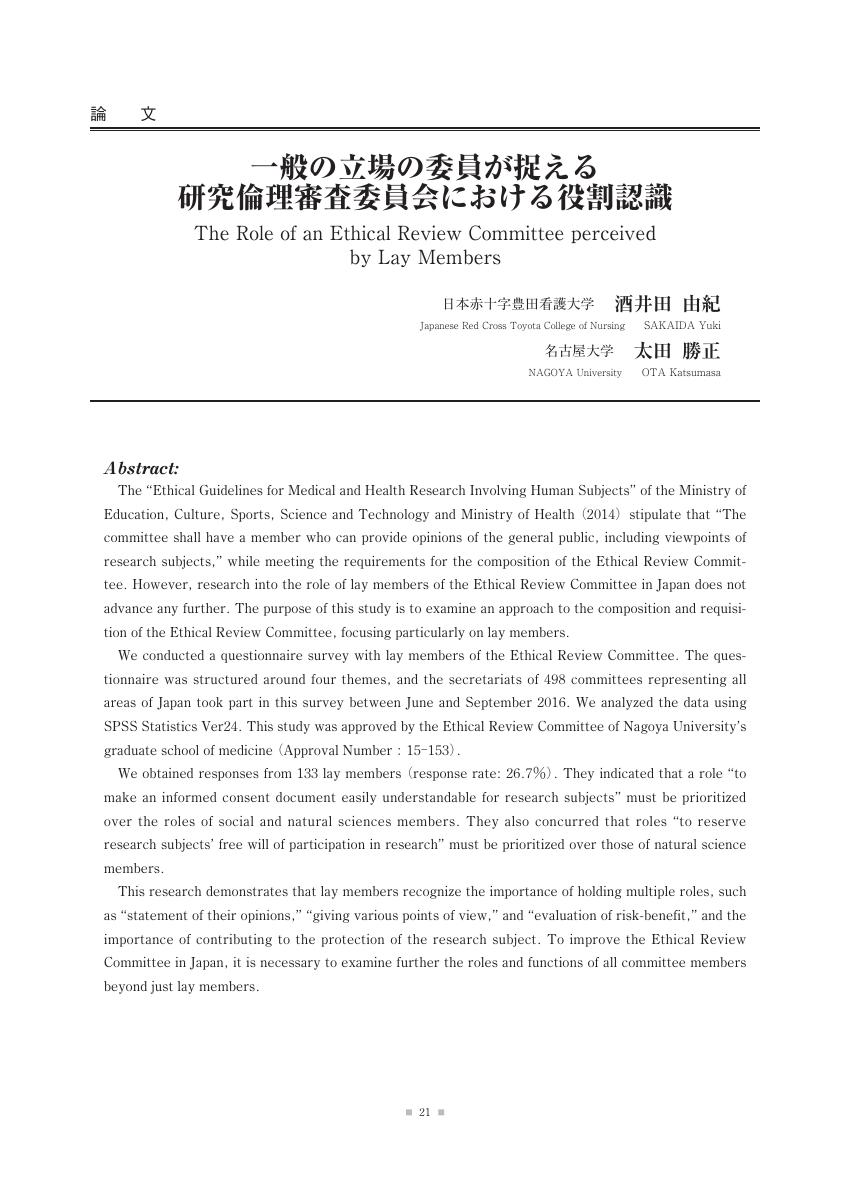1 0 0 0 OA 小児腎移植における倫理的要件と医療者の責務
- 著者
- 田村 京子
- 出版者
- 日本医学哲学・倫理学会
- 雑誌
- 医学哲学 医学倫理 (ISSN:02896427)
- 巻号頁・発行日
- vol.37, pp.14-23, 2019 (Released:2022-07-20)
1 0 0 0 OA 公的医療保険制度の抜本的改革のための考察ー倫理的観点から
- 著者
- 森 禎徳
- 出版者
- 日本医学哲学・倫理学会
- 雑誌
- 医学哲学 医学倫理 (ISSN:02896427)
- 巻号頁・発行日
- vol.37, pp.24-33, 2019 (Released:2022-07-20)
1 0 0 0 OA 終末期の意思決定における自己決定権 アプローチはいかに補完されてきたか?
- 著者
- 秋葉 峻介
- 出版者
- 日本医学哲学・倫理学会
- 雑誌
- 医学哲学 医学倫理 (ISSN:02896427)
- 巻号頁・発行日
- vol.37, pp.45-52, 2019 (Released:2022-07-20)
1 0 0 0 OA 近代日本の「国民性」言説における身体観と道徳観 -国民道徳論と国定修身教科書から
- 著者
- 川端 美季
- 出版者
- 日本医学哲学・倫理学会
- 雑誌
- 医学哲学 医学倫理 (ISSN:02896427)
- 巻号頁・発行日
- vol.37, pp.53-60, 2019 (Released:2022-07-20)
1 0 0 0 OA 本邦の着床前胚染色体異数性検査(PGT-A)の現状と展望
- 著者
- 児玉 正幸
- 出版者
- 日本医学哲学・倫理学会
- 雑誌
- 医学哲学 医学倫理 (ISSN:02896427)
- 巻号頁・発行日
- vol.37, pp.61-69, 2019 (Released:2022-07-20)
1 0 0 0 OA 生物心理社会-スピリチュアルモデルと精神的人格
- 著者
- 杉岡 良彦
- 出版者
- 日本医学哲学・倫理学会
- 雑誌
- 医学哲学 医学倫理 (ISSN:02896427)
- 巻号頁・発行日
- vol.36, pp.32-41, 2018 (Released:2022-07-20)
1 0 0 0 OA 医療における苦情解決に関する考察 「患者の権利オンブズマン」の18年から
- 著者
- 平野 亙
- 出版者
- 日本医学哲学・倫理学会
- 雑誌
- 医学哲学 医学倫理 (ISSN:02896427)
- 巻号頁・発行日
- vol.36, pp.63-70, 2018 (Released:2022-07-20)
1 0 0 0 OA 重い障害を生きる子を通じて医の倫理を考える
- 著者
- 松永 正訓
- 出版者
- 日本医学哲学・倫理学会
- 雑誌
- 医学哲学 医学倫理 (ISSN:02896427)
- 巻号頁・発行日
- vol.36, pp.71-76, 2018 (Released:2022-07-20)
1 0 0 0 OA ケアの問題としての「尊厳死」―尊厳あるいのちをいかに支えるか―
- 著者
- 安藤 泰至 清水 哲郎
- 出版者
- 日本医学哲学・倫理学会
- 雑誌
- 医学哲学 医学倫理 (ISSN:02896427)
- 巻号頁・発行日
- vol.36, pp.77-79, 2018 (Released:2022-07-20)
1 0 0 0 OA ケアにおける「SOL 倫理とQOL 倫理」再考―医学で人間の生命の価値がはかれるのか?―
- 著者
- 村岡 潔
- 出版者
- 日本医学哲学・倫理学会
- 雑誌
- 医学哲学 医学倫理 (ISSN:02896427)
- 巻号頁・発行日
- vol.36, pp.80-84, 2018 (Released:2022-07-20)
1 0 0 0 OA 終末期医療のイメージ―歴史的観点から―
- 著者
- 香川 知晶
- 出版者
- 日本医学哲学・倫理学会
- 雑誌
- 医学哲学 医学倫理 (ISSN:02896427)
- 巻号頁・発行日
- vol.36, pp.85-89, 2018 (Released:2022-07-20)
1 0 0 0 OA 在宅医療と「尊厳ある死」
- 著者
- 足立 大樹
- 出版者
- 日本医学哲学・倫理学会
- 雑誌
- 医学哲学 医学倫理 (ISSN:02896427)
- 巻号頁・発行日
- vol.36, pp.90-95, 2018 (Released:2022-07-20)
1 0 0 0 OA ジェームズ・グリフィンの人権論とその生命倫理的意味
- 著者
- 遠藤 耕二
- 出版者
- 日本医学哲学・倫理学会
- 雑誌
- 医学哲学 医学倫理 (ISSN:02896427)
- 巻号頁・発行日
- vol.36, pp.1-9, 2018 (Released:2022-06-20)
1 0 0 0 OA 着床前遺伝子スクリーニング臨床適用に関する倫理的考察
- 著者
- 児玉 正幸
- 出版者
- 日本医学哲学・倫理学会
- 雑誌
- 医学哲学 医学倫理 (ISSN:02896427)
- 巻号頁・発行日
- vol.36, pp.10-20, 2018 (Released:2022-07-20)
1 0 0 0 OA 一般の立場の委員が捉える 研究倫理審査委員会における役割認識
- 著者
- 酒井田 由紀 太田 勝正
- 出版者
- 日本医学哲学・倫理学会
- 雑誌
- 医学哲学 医学倫理 (ISSN:02896427)
- 巻号頁・発行日
- vol.36, pp.21-31, 2018 (Released:2022-07-20)
1 0 0 0 インターネット上で活動する精子提供者の自己情報開示状況とその意識
- 著者
- 新田 あゆみ
- 出版者
- 日本医学哲学・倫理学会
- 雑誌
- 医学哲学医学倫理 = Annals of the Japanese Association for Philosophical and Ethical Researches of Medicine (ISSN:02896427)
- 巻号頁・発行日
- no.38, pp.57-64, 2020
1 0 0 0 近代内モンゴルにおける伝統医学の史的変容
- 著者
- 財吉拉胡
- 出版者
- 日本医学哲学・倫理学会
- 雑誌
- 医学哲学 医学倫理 (ISSN:02896427)
- 巻号頁・発行日
- vol.32, pp.43-52, 2014
Traditional Mongolian medicine is a system that assimilates both the theory and practice of Tibetan medicine, which entered into Mongolian society along with the spread of Tibetan Buddhism over the last several centuries. Traditional medicine in Inner Mongolia was then forcibly modernized when the Japanese colonial medical enterprise developed in Manchuria and Inner Mongolia during the first half of the 20th century. Moreover, after the establishment of People's Republic of China, western modern medicine was popularized throughout China, including Inner Mongolia. Meanwhile, traditional Chinese medicine too became widespread into the Mongolian-settled areas, as ethnic Han Chinese people settled in Inner Mongolia. Mongolian medicine was then admitted into the official professional medical sector by the government, alongside Chinese medicine. Subsequently, the government established institutions in the higher educational system for traditional Mongolian medicine and set up traditional medical hospitals. In recent decades, however, with the spread of globalization, this medicine has lost its main position in the medical order of Mongolian society and gradually been transformed into an ethnically sustainable form of alternative medicine. For traditional Mongolian medicine to sustain itself alongside other types of practice will involve continuing modernization to satisfy the needs of local consumers.
- 著者
- 工藤 せい子 五十嵐 靖彦
- 出版者
- 日本医学哲学・倫理学会
- 雑誌
- 医学哲学 医学倫理 (ISSN:02896427)
- 巻号頁・発行日
- vol.24, pp.75-84, 2006
The purpose of this study was to attempt to determine general ideas for addressing ethical issues in nursing practice. The author interviewed nurses who had experienced cases involving care and related ethical issues. The interview data were analyzed using qualitative research methods. The subjects of analysis were the following three cases: 1. A client who was transferred to the hospital for reoperation but died shortly before operation; 2. A client who was in and out of the hospital for more than 10years because of incurable illness; and 3. A client whose last wish was fulfilled in the form of a Christmas party. Analysis showed that ideas for addressing ethical issues converged into two categories. The first included ethical issues, including "role as the client's advocate," "coordination between the client's wishes and the doctor's policy," and "paternalism and maternalism". The other category included issues related to caring, including "learning from the client," "formation of a strong bond resulting from mutual relationship," "involvement as a team," and "departure from medical rules". There were, in addition, three keys to addressing ethical issues that did not fit into either category: "hope for peaceful settlement of affairs," "hope for successful communication," and "wish to be treated indulgently". These three keys are useful both in care for patients and addressing ethical issues.
- 著者
- 福田 八寿絵
- 出版者
- 日本医学哲学・倫理学会
- 雑誌
- 医学哲学 医学倫理 (ISSN:02896427)
- 巻号頁・発行日
- vol.27, pp.52-59, 2009
Human papillomavirus (HPV) causes cervical cancer, and efforts to develop vaccines against this virus have been proceeding. In June 2006, the U.S. FDA approved a vaccine that prevents HPV. There is now a political controversy over how to use this HPV vaccine in the clinical setting. Because of the high prevalence of cervical cancer in Japan, this vaccine has been eagerly awaited. This paper examines the experience in the U.S. and discusses how this vaccine might be used in Japan where it has not yet been approved and considers how the cost should be borne as well as the ethical problems involved in selecting individuals to receive preventive vaccination.
- 著者
- ハイネマン トーマス 松田 純
- 出版者
- 日本医学哲学・倫理学会
- 雑誌
- 医学哲学 医学倫理 (ISSN:02896427)
- 巻号頁・発行日
- vol.33, pp.74-81, 2015














